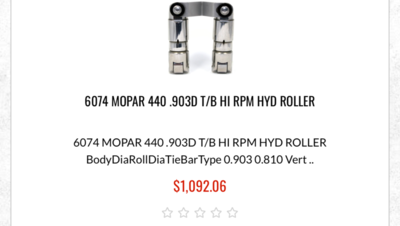That's my BIG question, and I have a VESTED INTEREST in the replies
@Dan64 gets here.
My local engine builder who built our Pontiac 421 Tripower suggested the CompCams
hydraulic roller cam and lifters. I haven't been given ANY warning nor instructions on doing maintenance
or inspections on them. They are quiet in operation, and have worked flawlessly. Rare quarter mile track use (so far, but once the carbs are rebuilt to high performance specs, that could increase to twice a month) a full week of Cruisin the Coast every year, and that includes
lots of stop and go traffic and idling. I can't compare that to the 541 stroker Mopar I plan on building, because the Pontiac has a .510" lift and only 345# spring pressure.
I am sure that the lift on my 541 will be higher, and higher spring pressure. Same for the OP, but
from all of the information I've been reading in  AndyF's book, the OP IS a good candidate for hydraulic roller cam and lifters
AndyF's book, the OP IS a good candidate for hydraulic roller cam and lifters, because of CAM lift at .600 or less in his case, as long as spring pressure doesn't disqualify their use.
My only 2 concerns for the OP using hydraulic roller lifters is the RPM range with the Max Wedge ports and depending on the cam, how high that combination may PUSH the RPM range UP. It is clear to me that AndyF is ok with hydraulic lifters to 6k RPM and 6,500 to 7k RPM
max.
The 2nd "problem" for me is more individual choice. As much as I would LOVE the seemingly maintenance free? operation of hydraulic roller lifters, I feel compelled to abide by my friend and one of my mentors Jim Laroy's firm decision NOT TO USE ANY HYDRAULIC LIFTERS, even though the hydraulic flat tappet CompCams lifters in my 440 292°/.509 cam w/911-16 CompCams springs at 373 pounds of pressure performs FLAWLESSLY on a regular basis to 6,200 RPMs!

 AndyF's book,
AndyF's book, 















